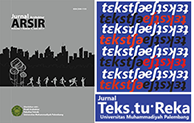Analisis Semiotik antara Lingkungan Binaan dengan Lingkungan Sosial-Politik: Studi Kasus pada Arsitektur Masjid Provinsi di Indonesia
Sari
Artikel ini mempelajari hubungan arsitektur masjid provinsi di Indonesia dengan sistem sosio-politik masyarakat, khususnya masyarakat muslim dan non-muslim melalui teori semiotika. Hal ini menarik karena adanya latar belakang masyarakat yang majemuk diikuti dengan adanya keanekaragaman arsitektur masjid. Artikel ini memiliki tiga tujuan: pertama, melihat hubungan antara dimensi masjid dan populasi masyarakat muslim di suatu provinsi, kedua, melihat hubungan antara arsitektur masjid dengan jumlah masyarakat muslim dan ketiga, melihat hubungan antara penamaan masjid dengan lingkungan sosio-politik agama. Data kuantitatif 31 masjid provinsi di Indonesia dianalisis menggunakan analisis korelasi dan Fisher’s exact test. Penelitian ini berdasarkan data sekunder dari basis data Kementerian Agama Republik Indonesia. Hasil penelitian ini mengungkapkan bahwa: luas lahan masjid dan daya tampung masjid berkorelasi dengan jumlah dan proporsi masyarakat muslim di suatu provinsi. Sementara itu, arsitektur atap masjid yang berbentuk pyramidal roof ditemukan di provinsi yang penduduknya mayoritas suku Jawa. Nama masjid yang bersifat asertif ditemukan di provinsi yang jumlah masyarakat muslim dan non-muslim relatif seimbang. Hal ini menunjukkan bahwa secara sadar atau tidak, kondisi lingkungan politik, agama dan etnis memiliki peran penting dalam arsitektur masjid provinsi di Indonesia..
Kata Kunci
Teks Lengkap:
PDF (English)Referensi
Asholat. (2016). Hukum Mendirikan Shaf Shalat di Antara Tiang. Retrieved April 20, 2019, from https://www.asholat.com/2016/05/hukum-mendirikan-shaf-shalat-di-antara.html
Azaryahu, M., & Kook, R. (2002). Mapping the nation : street names and Arab-Palestinian identity : three case studies. Nations and Nationalism, 8(2), 195–213.
Barthes, R. (1977). Elements of Semiology. New York: Hill & Wang.
Boender, W. (2018). Urban Islam in the Netherlands: What Mosques can tell. Islamology, 8(1), 26–42.
Central Agency of Statistics. (2011). Penduduk Menurut Wilayah dan Agama yang Dianut (Population according to Area and Religion Adhered).
Davies, N., & Jokiniemi, E. (2008). Dictionary of Architecture and Building Construction. Paris: Elsevier.
de Saussure, F. (2011). Course in General Linguistics. New York: Columbia University Press.
Falah, S. M. (2018). The Shrine that Consumed Its Town : The Role of Religion and Politics in Reshaping the Iraqi City of Najaf. University of Cincinnati.
Fisher, R. A. (1954). Statistical Methods for Research Workers. Edinburgh: Oliver and Boyd.
Grabar, O. (2001). Art and Architecture and the Qur’?n. In Encyclopaedia of the Qur’?n: A-D (pp. 161–175). Brill.
Hasan, I. (2009). Architecture and the Politics of Identity in Indonesia A Study of the Cultural History of Aceh. University of Adelaide.
Hasan, S. (2018). Minarets, alcoves, domes and devotion. Retrieved June 19, 2019, from https://www.dawn.com/news/1411582
Indrawati, Soetomo, S., Setioko, B., Murtini, T. W., & Nurhasan. (2016). Edu-Religious Tourism Based on Islamic Architecture Approach: A Preliminary Research in Majasto Cemetery - Sukoharjo Regency, Central Java. Procedia - Social and Behavioral Sciences, 227, 656–663. https://doi.org/10.1016/j.sbspro.2016.06.129
Isin, E. F., & Siemiatycki, M. (1999). Fate and Faith: Claiming Urban Citizenship In Immigrant Toronto (No. 8). Toronto.
Ismail, A. S., & Rasdi, M. T. M. (2010). Mosque architecture and political agenda in twentieth-century Malaysia. The Journal of Architecture, 15(2), 137–152. https://doi.org/10.1080/13602361003791051
Jurco, A. N., Bodea, S. M., Crisan, H. G., & Scurtu, I. (2017). Method to Develop the Double-Curved Surface of the Roof. JIDEG, 12(1), 55–58.
Kami, I. M. (2019). Desainnya Dituduh Illuminati, RK Tunjukkan Masjid-masjid Rancangannya. Retrieved June 19, 2019, from https://news.detik.com/berita/d-4572366/desainnya-dituduh-illuminati-rk-tunjukkan-masjid-masjid-rancangannya
Kassim, D. H., Putra, A., Nor, M. J. M., & Muhammad, N. S. (2014). Effect of Pyramidal Dome Geometry on the Acoustical Characteristics in a Mosque. Journal of Mechanical Engineering and Sciences, 7, 1127–1133.
Koskinen, I., & Hush, G. (2016). Utopian, Molecular and Sociological Social Design. International Journal of Design, 10(1), 65–71.
Levy, M. Z., Barbu, C. M., Castillo-neyra, R., Quispe-machaca, V. R., Ancca-juarez, J., Escalante-mejia, P., … Chagas Disease Working Group in Arequipa Peru. (2014). Urbanization , land tenure security and vector-borne Chagas disease. Proceeding of the Royal Society B, 281, 20141003.
Ministry of Religon. (2019). Daftar Profil Masjid Raya (Great Mosques Profiles List). Retrieved July 26, 2019, from http://simas.kemenag.go.id/index.php/profil/masjid/page/?tipologi_id=2
Nawawi, N. M., Kassim, S. J., & Ibrahim, M. (2018). The Mosque in a Multicultural Context: Modernity, Hybridity and Eclecticism. In S. J. Kassim & Pitt (Eds.), Modernity, Nation and Urban-Architectural Form (pp. 31–58). Springer International Publishing. https://doi.org/10.1007/978-3-319-66131-5
Ndana, N. (2007). From Kalwinamaano through Mukavendiimi to Mbweene : Verbal Indirectness, Dog Names and Subiya Social Experience. NAWA Journal of Language and Communication, 1(2).
Ory, S. (2001). Calligraphy. In Encyclopaedia of the Qur’?n: A-D (pp. 278–286). Brill.
Othman, R., Inangda, N., & Ahmad, Y. (2009). A typological study of mosque internal spatial arrangement : A case study on Malaysian mosques ( 1700-2007 ). Journal of Design and the Built Environment, 41–54.
Prijotomo, J. (1996). When West Meets East : One Century of Architecture in Indonesia (1890s-1990s). Architronic, 5(3), 1–10.
Sani, R. M. (2009). An Inquiry into Iranian Architecture Manifestation of Identity, Symbolism, and Power in the Safavid’s Public Buildings. Eastern Mediterranean University.
Taib, M., & Rasdi, M. T. (2012). Islamic Architecture Evolution : Perception and Behaviour. Procedia - Social and Behavioral Sciences, 49, 293–303. https://doi.org/10.1016/j.sbspro.2012.07.027
Yacobi, H., Ventura, J., & Danzig, S. (2016). Walls, Enclaves and the (Counter) Politics of Design. Journal of Urban Design, 21(4), 481–494.
Zhang, H., Chi, S., Yang, J., & Wang, T.-K. (2012). Efficient safety information retrieval on construction sites: a preliminary methodology. In Proceedings of ICSDEC2012. Developing the Frontier of Sustainable Design, Engineering, and Construction. Fort Worth, Texas.
Zielstra, D., & Hochmair, H. H. (2013). Positional accuracy analysis of Flickr and Panoramio images for selected world regions. Journal of Spatial Science, 58(2), 251–273.
DOI: https://doi.org/10.32502/arsir.v5i2.4054
Refbacks
- Saat ini tidak ada refbacks.
Indexed by:

Arsir : Jurnal Arsitektur is lisenced under a Creative Commons Attribution-ShareAlike 4.0 International License.









